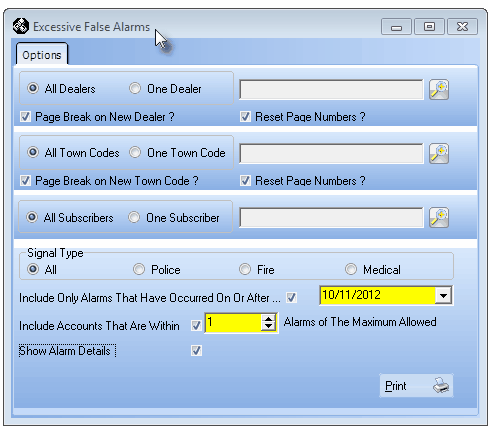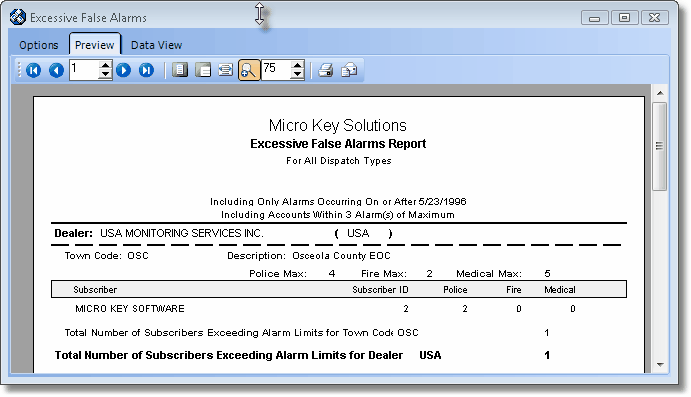| □ | Assuming that you are using False Alarm Dispatch Tracking to help you understand the problem and reduce the incidence of invalid alarms being dispatched, this Excessive False Alarms report provides a detailed analysis of who, what, and why these alarms are occurring. |
| • | To view the Excessive False Alarms Report, on the Main Menu Select Reports and Choose the Central Station sub-menu then Click Excessive False Alarms. |
| □ | Excessive False Alarms tabs - There are three tabs on the Excessive False Alarms dialog. |
| • | Options - Initially only the Options tab is shown (until you make your Options selections and Select Print). |

Excessive False Alarms Options dialog
| • | Dealer Information Setup - Determine which Dealers who have Accounts with excessive False Alarms will be reported, and how the report will be formatted. |
| ▪ | All Dealers - By default, All Dealers and their Accounts will be listed. |
| ▪ | One Dealer - If you want to report on one Dealer only, Click this button. |
| ▪ | Dealer Name Search - Click the Search to select the desired Dealer. |
| ▪ | Page Break on New Dealer? - Once your Company's alarm Accounts are listed, this report lists in Alarm Dealer order. |
| ▪ | To format the report so that each new Dealer starts a new page, Check this box. |
| ▪ | Reset Page Numbers? - If you are starting a new page for each new Dealer and want to re-start the page number as well, Check this box. |
| • | Town Code Information Setup - Because some Municipalities may not have a False Alarm Penalty, you may indicate which Town Code will be included in the report. |
| ▪ | All Town Codes - By default, All Town Codes will be included in the report. |
| ▪ | One Town Code - If you want to report on one Town Code only, Click this button. |
| ▪ | Town Code Search - Click the Search to select the desired Town Code. |
| ▪ | Page Break on Town Code? - To format the report so that each new Town Code starts a new page, Check this box. |
| ▪ | Reset Page Numbers? - If you are starting a new page for each new Town Code and want to re-start the page number as well, Check this box. |
| • | Subscriber Information Setup - You may get a report for a specific Subscriber, if required. |
| ▪ | All Subscribers - By default, All Subscribers will be included in the report. |
| ▪ | One Subscriber - If you want to report on one Subscriber only, Click this button. |
| ▪ | Subscriber Search - Click the Search to selected the desired Subscriber. |
| • | Signal Type -All Emergency Signals are included in the report unless you specify otherwise. |
| ▪ | All - By default, All Emergency Signals are included. |
| ▪ | Police - If you want to only report on False Alarms that required the Police to respond, Click this button. |
| ▪ | Fire - If you want to only report on False Alarms that required the Fire Department to respond, Click this button. |
| ▪ | Medical - If you want to only report on False Alarms that required Medical Responders, Click this button. |
| • | Filtering the Results - You may further restrict which Accounts will be included. |
| ▪ | Include Only Alarms That Have Occurred On or After... - To restrict which False Alarms will be used - based on the date of occurrence - to determine the Accounts listed in the report, Check this box. |
| ▪ | Start Date Selector field - If you Checked the box noted above, use the Drop-Down Date Selection Box to enter the appropriate date. |
| ▪ | Include Accounts That Are Within - If you also want to include Accounts that have almost reached their Maximum Allowable Alarms, Check this box. |
| ▪ | Number of False Alarms Until the Maximum Allowable is reached - If you Checked the box noted above, enter that number. |
| ▪ | Show Alarm Details - To include the details of each alarm event reported, Check this box. |
| • | Print - Click the Print button  to Preview and optionally Print (to a File or a Printer) this Excessive False Alarms Report. to Preview and optionally Print (to a File or a Printer) this Excessive False Alarms Report. |
| • | Preview - The Preview tab presents the report which resulted from the Options you've selected. |
| • | Up Arrow/Down Arrow - hi - Moves the report one line up, or one line line down, respectively. |
| • | Page Up/Page Down - Moves the report to the previous or next page, respectively. |

Excessive False Alarms Report Preview
| • | Home -  - Using either the screen or your Keyboard's Home key, moves the report to the top of the first page. - Using either the screen or your Keyboard's Home key, moves the report to the top of the first page. |
| • | End -  - Using either the screen or your Keyboard's End key, moves the report to the bottom of the last page. - Using either the screen or your Keyboard's End key, moves the report to the bottom of the last page. |
| • | Arrows - The arrows allow you to move back and forth, from page to page. |
| • | Number - Indicates the page number you are viewing. |
| ▪ | You may also type in a specific page number, Press 8 Enter and that page will be displayed immediately. |
| ▪ | If you enter an invalid page number, it will be ignored. |
| • | Fit To Page - Click the first button after the arrows to size a full page of the report to fit the screen. |
| • | Zoom To 100% - Click the second button after the arrows to display the page at 100% (of the printed view). |
| • | Fit To Page Width - Click the third button after the arrows to size the page of the report to fit the full width of the screen. |
| • | Zoom To Percentage - Click the fourth button after the arrows to re-size the page of the report by percentage. |

| ▪ | When you Click the Zoom To Percentage button, the Percentage selector will be displayed. |
| ▪ | You may then Click the Up or Down ‚ arrows to set the exact amount of Zoom you want. |
| • | Print - Click the Print button to Print (to a File or a Printer)  the displayed Excessive False Alarms. the displayed Excessive False Alarms. |
| • | Email - Click the Email  button to send this report to an Email address of your choosing. button to send this report to an Email address of your choosing. |
| • | To Exit the Preview tab and Close this Report dialog Form, Click the Close button x on the right at the top of the Preview tab. |
| • | Data View - This view provides a tabular (spreadsheet style) presentation of the selected data. |

Excessive False Alarms Data View
| • | Arrows - Click the arrows to move through the record. |
| • | Export - Exporting the data from this Data View tab (note the "fly-over" help available on these buttons): |
| ▪ | Export to CSV - Click the first button after the arrows to export the data to a Comma Separated Values (CSV) file format. |
| ▪ | Export To Excel - Click the second button after the arrows to export the data to an Excel (.xls) file format. |
| ▪ | Export To Html - Click the third button after the arrows to export the data to an HTML formatted file. |
| • | To Exit the Data View tab and Close this Report dialog Form, Click the Close button x on the right at the top of the Data View tab. |










![]()
